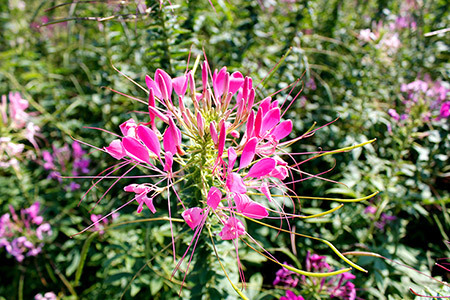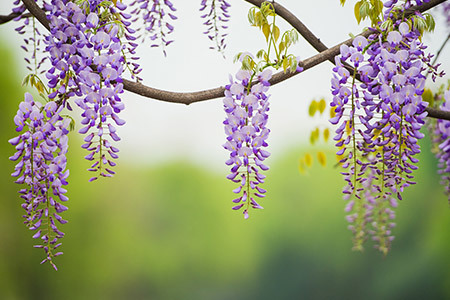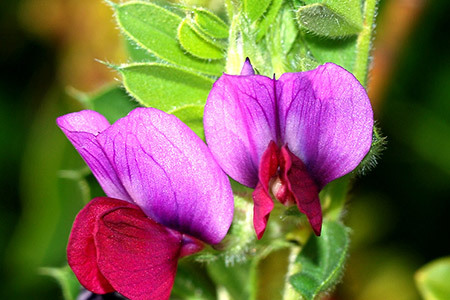Perennial hybrid foxtail grass
A landscaping and flower seed company mainly engaged in the production, sales, and export of flower seeds, tree seeds, forage seeds, green manure seeds, lawn seeds, and medicinal herb seeds.
Classification:
Forage and green manure seeds
Telephone:
Product Description
1. Botanical Characteristics of Hybrid Foxtail Grass
Perennial. It has a fibrous root system, with deep and dense roots, strong drought and flood resistance. A single plant can form numerous branches; the more soil is cultivated and the more it is cut, the more branches it produces, reaching up to 200 branches at most. Seeds germinate 5-7 days after sowing. With high temperatures and sufficient nutrients and water, the plants grow rapidly, have strong regeneration ability, and can be continuously cut and utilized. The critical growth temperature for hybrid foxtail grass is 10-15°C, allowing it to grow year-round in tropical and subtropical regions, producing grass throughout the year, and the grassland can be utilized continuously for many years.
The suitable temperature for seed germination is 28-30°C. Sowing must occur in early spring when the soil temperature stabilizes above 15°C, and it should not be too early. The most suitable growing season is summer, with an average daily temperature of 25-30°C, where growth is fastest.
Hybrid foxtail grass is very sensitive to quick-acting fertilizers, especially nitrogen fertilizers, with a recommended dosage of 40 kg per mu. The effect of organic fertilizers on yield increase is not significant.
Hybrid foxtail grass is perennial and can be continuously cut for 8 years, with 5-8 cuts per year, yielding 12-15 tons of fresh grass per mu per year. In southern high-temperature regions, it can grow to 1.2 meters within 30 days after sowing, allowing for the first cut. After each cut, it is recommended to apply 10 kg of urea per mu after rain to promote the growth of young shoots.
Hybrid foxtail grass is tender and juicy, favored by cattle, sheep, horses, rabbits, and fish, with high nutritional value and yield. It is drought-resistant and flood-resistant, requiring extensive management. Once planted, it can be continuously used for 8 years. With the promotion in recent years, it has gradually become the preferred high-yield, high-quality forage variety in southern livestock farming.
2. Excellent Characteristics of Hybrid Foxtail Grass
1. One-time planting, multiple years of use
Hybrid foxtail grass is a perennial grass species that can be utilized for many years after one-time planting. When used as forage, it can typically be utilized for at least 5 years, with some lasting up to 10-15 years or even longer. To achieve sustained high and stable yields, it is often necessary to plow and harrow the grassland after the 4th to 5th year to obtain high yields.
2. High-quality products
Hybrid foxtail grass fully integrates the high yield of elephant grass and the palatability of American foxtail grass, showing significant hybrid advantages.
First, high yield. When used for feeding large herbivores like cattle and sheep, the fresh grass yield of hybrid foxtail grass can reach 10,000-15,000 kg in the first year after planting, with some even exceeding 20,000 kg. The yield in the 2nd and 3rd years is higher than in the first year, with an average annual increase of 30%-50%.
Second, good quality. Compared to elephant grass, hybrid foxtail grass is richer in nutrients, with crude protein content reaching 13.18%.
Third, good palatability and safe feeding. The stems and leaves of hybrid foxtail grass are tender, with smooth and hairless leaf sheaths. The grass is thick, soft, and palatable, favored by various livestock, poultry, and fish, with a fresh grass utilization rate of over 90%. In contrast, elephant grass has hairy leaf sheaths, thin and coarse grass, poor palatability, and low utilization.
Fourth, abundant leaf volume and small stem-to-leaf ratio. Hybrid foxtail grass has thin stems and many leaves, with a single plant typically having up to 20 leaf segments. After multiple cuts, the number of leaf segments can increase exponentially; under sufficient light, nutrients, and water, a single plant can have over 200 leaf segments. Additionally, it has been measured that the stem-to-leaf ratio of hybrid foxtail grass is 0.84, while that of elephant grass is 1.01.
3. Strong regeneration ability and tolerance to cutting
Hybrid foxtail grass has an extremely strong regeneration ability and is very tolerant to cutting. Generally, it can be cut once every month, allowing for 6-8 cuts per year. When used for feeding pigs, rabbits, poultry, and fish, it can be cut when the plant height reaches 60-80 cm, shortening the cutting time and increasing the number of cuts.
4. Strong adaptability and wide sowing area
Hybrid foxtail grass has strong adaptability and a wide sowing area. It can generally be cultivated in mountainous, hilly, plateau, plain, and coastal areas below 800 meters in altitude and with minimum temperatures above 0-5°C. Additionally, hybrid foxtail grass is not strict about soil requirements and can grow in various soil types. However, warm and humid climates and fertile sandy soils are most suitable for its growth, conducive to achieving high yields.
5. Strong resistance to adversity
1.) Drought and lodging resistance. Hybrid foxtail grass has deep and dense roots, with a well-developed fibrous root system concentrated mainly in the 0-30 cm soil layer, making it very drought-resistant and also strong against lodging.
2.) Cold and heat resistance. Hybrid foxtail grass is native to tropical and subtropical regions, so warm and humid climates are very beneficial for its growth. It begins to grow when the average daily temperature reaches above 15°C, grows fastest at 25-35°C, and can withstand high temperatures above 40°C and low temperatures below 10°C, as well as light frost for short periods. Generally, when the temperature is below 10°C, growth is significantly inhibited, but when other summer and autumn grasses stop growing at 7-8°C, it can still grow slowly. In my province, hybrid foxtail grass can generally overwinter naturally, but in some areas, if the temperature remains at 0°C for too long, these areas need to protect the seedlings with plastic film for winter.
3.) Strong resistance to pests and diseases, easy to manage. Hybrid foxtail grass has a very strong resistance to pests and diseases. According to relevant data, after being introduced and widely planted in China, no significant pest or disease damage has been reported for many years.
4.) Strong salt and alkali resistance. Experiments have shown that hybrid foxtail grass grows well in soils with a chloride salt content of 0.3%, and it can still survive in soils with a chloride salt content of 0.5%. This characteristic is very beneficial for its cultivation in saline-alkali land.
6. Fast coverage and strong sediment interception ability
Hybrid foxtail grass is not only an excellent forage but also a good ecological and water conservation grass species. It grows quickly, has deep and dense roots, and a well-developed fibrous root system, allowing it to quickly cover the ground and effectively intercept sediment.
7. Long utilization period, wide application range, and significant breeding benefits. In Guangdong, hybrid foxtail millet can be sown as early as March, generally starting to be utilized by May, and can be continuously used until December, with a utilization period lasting seven to eight months. Grasslands planted with hybrid foxtail millet can be directly used for grazing or cutting fresh grass. The cut fresh grass can be directly used for green feeding or silage. Hybrid foxtail millet can be used to feed various livestock, poultry, and fish, making its application range extremely broad. At the same time, it also shows outstanding advantages in high efficiency and high economic benefits, with significant breeding benefits. According to calculations by Zheng Chenzhong and others from the Raoping County Agricultural Bureau, feeding dairy cows with hybrid foxtail millet, compared to feeding with weeds, can increase the milk yield of a cow by about 350 kg during a lactation period, reducing costs by 400 yuan. Using hybrid foxtail millet to raise fish leads to faster growth, and the feeding is safe and labor-saving. Compared to feeding with cabbage, using hybrid foxtail millet to raise geese results in significant weight gain, allowing for earlier market release and higher profits, while also replacing part of the feed grain, thus saving feed. In recent years, the application of hybrid foxtail millet in pig farming has attracted much attention from pig farmers, and its application range is expanding. Using hybrid foxtail millet for pig farming not only reduces environmental pollution from pig farms but also improves pig farming efficiency. For example, the Xiamen Guorong Biological Economic Research Institute, under the guidance of experts and professors from Fujian Agriculture and Forestry University and the Chinese Academy of Agricultural Sciences, has achieved successful research on "high-quality ecological pig production technology" through years of experiments and discussions. This technology mainly focuses on the "pig-biogas-grass" engineering model, using hybrid foxtail millet as the main green feed for pig farming, utilizing pig excrement to produce biogas, and using biogas slurry to fertilize the soil and promote the growth of hybrid foxtail millet, forming a good circular utilization system. The ecological pork produced using this technology, although priced 20% to 30% higher than regular pork in the market, and internal organs and ribs priced 50% higher than ordinary pork, has won the favor of a wide range of consumers due to its hygiene, health, nutrition, and delicious taste, receiving a significant social response.
Key words:
Immediate consultation
If you are interested in our products, please leave your email, we will contact you as soon as possible, thank you!
Product recommend
RELATED INFORMATION
02
/
12
News dynamics
01
/
30
News dynamics
07
/
17
News dynamics
04
/
18
News dynamics
01
/
19
News dynamics
Urban greening is an important component of urban construction.







